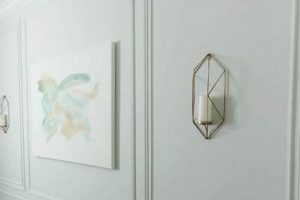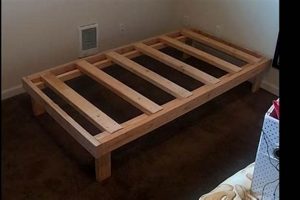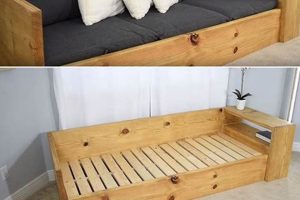A do-it-yourself construction designed to encase and display completed jigsaw puzzles, providing both protection and aesthetic enhancement. These constructions utilize readily available materials and basic tools, enabling individuals to create customized enclosures tailored to specific puzzle dimensions and personal preferences.
The creation of a customized enclosure offers several advantages. It safeguards the finished puzzle from dust, damage, and accidental disassembly, thereby preserving the artwork for extended periods. Moreover, a self-made display allows for cost-effective personalization, enabling the selection of materials and finishes that complement the puzzle’s imagery and the surrounding dcor. Historically, mounting puzzles presented challenges due to size and fragility; this approach provides a practical and visually appealing solution.
The subsequent discussion will address the necessary materials, construction techniques, and design considerations involved in assembling a personalized display for jigsaw puzzles. Key aspects will include material selection, precise measurement and cutting, secure assembly methods, and finishing options to ensure a professional and durable final product.
Tips for Crafting a Superior Enclosure
Considerations prior to commencing construction are paramount to achieving a satisfactory result. Attention to detail in the planning and execution phases minimizes errors and ensures structural integrity.
Tip 1: Accurate Measurement is Critical: Precise measurements of the completed jigsaw puzzle are essential. Account for any slight variations in size, and add a small allowance (approximately 1/8 inch) to prevent the puzzle from binding within the constructed enclosure.
Tip 2: Material Selection Influences Longevity: Opt for high-quality materials suitable for the intended environment. Consider factors such as humidity, temperature, and potential for impact. Hardwoods or sturdy plywood offer increased durability compared to softer woods.
Tip 3: Secure Fastening Techniques Enhance Stability: Employ robust fastening methods, such as wood glue combined with screws or nails. Proper clamping during adhesive curing ensures strong, lasting bonds. Avoid relying solely on brad nails, which may lack sufficient holding power over time.
Tip 4: Mitered Corners Present a Professional Aesthetic: Mitered corners, cut at 45-degree angles, provide a seamless, refined appearance. Use a miter saw or miter box to achieve accurate angles. Ensure the corners align precisely before fastening.
Tip 5: Consider a Backing Board for Added Support: Incorporating a rigid backing board, such as hardboard or foam board, adds structural support to the puzzle within the enclosure. Secure the puzzle to the backing board with archival-quality adhesive or double-sided tape.
Tip 6: Protective Glazing Preserves the Puzzle’s Integrity: Opt for acrylic or glass glazing to shield the puzzle from dust, UV radiation, and physical damage. Ensure the glazing is securely installed and does not exert undue pressure on the puzzle surface.
Tip 7: Sanding and Finishing Elevate the Final Result: Thorough sanding removes imperfections and creates a smooth surface for finishing. Apply a sealant, stain, or paint to protect the wood and enhance its aesthetic appeal. Allow ample drying time between coats.
Adherence to these principles promotes a finished product characterized by both visual appeal and long-term structural soundness. The result is a durable and attractive display, effectively safeguarding the encased puzzle.
The subsequent section will address advanced techniques and troubleshooting common challenges encountered during the construction process, ensuring a comprehensive understanding of the subject matter.
1. Precise Measurements
Accurate dimensional assessment is foundational to the successful fabrication of a do-it-yourself puzzle enclosure. Deviations from precise measurements can compromise the structure’s integrity and aesthetic quality, ultimately diminishing the display’s effectiveness.
- Puzzle Dimension Conformity
The internal dimensions of the enclosure must correspond precisely with the external dimensions of the completed jigsaw puzzle. A tight fit can cause the puzzle to warp or buckle, while excessive space allows for unwanted movement and potential damage. For instance, if a puzzle is measured as 20 inches by 30 inches, the interior of the created enclosure should be exactly that size, or very slightly larger (e.g., 20 1/8 inches by 30 1/8 inches) to allow for easy insertion and removal.
- Material Thickness Compensation
The thickness of the chosen framing material must be accounted for in the overall dimensional calculations. The exterior dimensions of the enclosure will necessarily exceed the interior dimensions by twice the thickness of the material on each side. Failure to factor in this consideration can result in an enclosure that is either too small or too large for the intended puzzle. For example, using wood that is 1/2 inch thick means adding 1 inch to both the length and width of the interior dimensions to derive the exterior dimensions that will be cut.
- Angle Accuracy in Mitered Cuts
When employing mitered corners, the accuracy of the 45-degree angle cuts is paramount. Inaccurate angles will result in gaps or overlaps at the corners, detracting from the aesthetic appeal and compromising the structural integrity of the frame. An angle deviating by even a single degree can accumulate noticeably across all four corners, leading to a skewed or misshapen construction. The use of a precision miter saw or miter box is recommended.
- Glazing Panel Fit
If a protective glazing panel is to be incorporated, its dimensions must be equally precise. An ill-fitting panel can rattle within the enclosure or, conversely, exert undue pressure on the puzzle surface. The glazing panel should be measured and cut with tolerances similar to those applied to the framing material, ensuring a snug yet non-restrictive fit. Consider that acrylic glazing expands/contracts more than glass with changes in temperature so leaving a slightly larger allowance is prudent.
These dimensional considerations are not merely technicalities but are fundamental to the successful execution of a puzzle enclosure. Rigorous attention to measurement detail ensures a professional finish, preserving the puzzle’s integrity and enhancing its presentation.
2. Material Selection
The choice of materials in a do-it-yourself puzzle enclosure project directly influences the structure’s longevity, aesthetic appeal, and overall protective capability. Selecting inappropriate materials can lead to structural failure, visual incongruity, or inadequate protection of the encased puzzle. Conversely, judicious material selection contributes to a durable, visually pleasing, and protective display.
Considerations extend beyond mere aesthetics. The weight-bearing capacity of the selected wood or composite material is crucial, particularly for larger puzzles. Softer woods, such as pine, may be suitable for smaller enclosures, but larger puzzles necessitate hardwoods like oak or maple, or engineered wood products like plywood or MDF, to prevent warping or sagging over time. The presence of knots or imperfections in the wood can weaken the structure and compromise its stability. Furthermore, the finish applied to the enclosure impacts its resistance to moisture, UV radiation, and physical damage. For instance, a polyurethane coating provides a durable, water-resistant finish suitable for environments with high humidity, while UV-resistant varnishes protect the puzzle from fading due to sunlight exposure. The choice of glazing material also dictates the level of protection afforded to the puzzle. Acrylic glazing offers impact resistance and UV protection, while glass provides superior clarity and scratch resistance. Real-world examples demonstrate the impact of material choices: an enclosure constructed from untreated pine and exposed to direct sunlight may warp and fade within a year, while one built from kiln-dried hardwood and finished with UV-resistant varnish can maintain its integrity for decades.
In conclusion, careful material selection is not a peripheral consideration but a core determinant of a do-it-yourself puzzle enclosure’s success. Understanding the properties of different materials and their suitability for specific environmental conditions and puzzle sizes is essential. Neglecting this aspect can lead to structural deficiencies, aesthetic compromises, and inadequate protection of the puzzle, ultimately undermining the project’s value.
3. Secure Fastening
Secure fastening represents a critical element in the construction of a do-it-yourself puzzle enclosure. Inadequate fastening techniques directly compromise the structural integrity of the frame, potentially leading to joint separation, warping, or complete failure. The purpose of fastening methods is to rigidly join the individual components of the frame, ensuring that it can withstand the stresses of handling, display, and environmental changes. For instance, relying solely on adhesive without mechanical fasteners (screws, nails) may result in joint failure over time, especially under fluctuating temperature or humidity conditions, causing the frame to separate. This is because adhesives can weaken or degrade over time. Proper fastening ensures the enclosure maintains its shape and continues to protect the puzzle within.
Various methods of secure fastening exist, each with its own advantages and disadvantages. Wood screws offer substantial holding power and allow for disassembly if necessary, making them suitable for larger, heavier frames or those requiring future adjustments. Nails, particularly finish nails, provide a more aesthetically pleasing result but offer less holding power and are not easily removed. Corner braces, metal or plastic, provide additional reinforcement at the corners, preventing them from pulling apart under stress. Combining different fastening techniques, such as using wood glue with screws, can maximize strength and durability. For example, a real-world application involves constructing a large puzzle enclosure where each corner joint is glued, screwed, and reinforced with a corner brace, guaranteeing the structure’s stability and resistance to warping.
In summary, secure fastening is not merely a construction detail but a fundamental prerequisite for a successful do-it-yourself puzzle enclosure. The choice of fastening methods directly influences the longevity, stability, and overall quality of the finished product. Understanding the principles of secure fastening and employing appropriate techniques ensures that the puzzle enclosure effectively protects and displays the puzzle for years to come.
4. Corner Aesthetics
Corner aesthetics significantly influence the overall perceived quality and visual appeal of a do-it-yourself puzzle enclosure. Poorly executed corners detract from the artwork, undermining the project’s purpose, while well-crafted corners enhance the display, lending a professional and refined appearance. The choice of corner construction technique mitered, butt joint, or decorative directly impacts the final aesthetic. Mitered corners, requiring precise 45-degree cuts, offer a seamless and sophisticated look, but demand accuracy and skill. Butt joints, simpler to execute, often appear less polished unless carefully concealed or intentionally highlighted as part of the design. Decorative corners, utilizing molding or corner blocks, provide visual interest but must complement the puzzle’s style and the surrounding decor to avoid a jarring effect. A poorly aligned or gap-filled corner immediately draws the eye, distracting from the puzzle itself.
The execution of corner joints dictates the perceived quality. Gaps, uneven surfaces, or visible fasteners detract from the overall aesthetic. Filling gaps with wood filler and sanding to a smooth finish improves the appearance, while concealing fasteners with wood plugs or strategically placed decorative elements enhances the professional look. The selection of corner joinery impacts the structural integrity. Weak corners compromise the frame’s stability, increasing the risk of warping or separation over time. For instance, using only glue on butt joints without additional reinforcement (screws, dowels, or metal braces) often results in corner failure, especially with larger enclosures. The finish applied to the corners must seamlessly blend with the rest of the frame. Uneven staining, mismatched paint colors, or drips of finish detract from the visual appeal, highlighting imperfections and undermining the aesthetic integrity.
Effective corner aesthetics are crucial to the success of a DIY puzzle frame. The specific techniques used depend on the builders skill, tools, and the desired style. Mitered corners demand precision while butt joints offer simplicity. The ultimate goal is to create corners that are not only structurally sound but visually harmonious, enhancing the puzzle display and conveying a sense of craftsmanship. Challenges include achieving perfect angles, seamlessly blending finishes, and choosing corner details that complement both the puzzle and the surrounding environment. Addressing these challenges elevates the overall quality and aesthetic value of the project.
5. Backing support
Backing support constitutes a fundamental element within the architecture of a do-it-yourself puzzle enclosure. Its presence or absence directly influences the longevity, stability, and overall presentation of the encased puzzle. Without adequate backing, the puzzle lacks structural integrity, predisposing it to warping, sagging, or separation, particularly in instances of larger or more intricate puzzles. The backing essentially creates a rigid plane against which the puzzle rests, distributing its weight evenly and preventing deformation over time. Consider a 1000-piece puzzle, lacking backing support, mounted vertically within a self-made frame. The force of gravity acting upon the puzzle can cause the bottom edge to sag, disrupting the image and potentially causing pieces to detach. Adding backing support eliminates this issue.
The implementation of backing support is multifaceted, encompassing material selection, secure attachment methods, and consideration of environmental factors. Materials range from inexpensive foam board to more durable hardboard or acid-free cardstock, each offering varying degrees of rigidity and archival quality. The selection hinges on the puzzle’s size, weight, and long-term preservation goals. Attachment methods include archival-safe adhesives, double-sided tape, or mechanical fasteners, each chosen to avoid damaging the puzzle while ensuring secure adhesion to the backing. Furthermore, the backing material should be resistant to moisture and temperature fluctuations, preventing warping or degradation that could impact the puzzle. For example, a puzzle mounted on moisture-absorbing cardboard in a humid environment will likely experience warping and mold growth, whereas one mounted on sealed hardboard remains stable.
In conclusion, backing support is not a mere optional addition but an integral component of a do-it-yourself puzzle enclosure. Its role in maintaining structural integrity, preventing damage, and ensuring long-term preservation is paramount. A lack of appropriate backing support compromises the puzzle’s presentation and increases its vulnerability to environmental factors and physical stress. Thoughtful material selection and secure attachment methods are vital for achieving a professional and enduring display, underscoring the practical significance of understanding backing’s role in this context.
6. Protective Glazing
Protective glazing constitutes a critical component within the construction of a do-it-yourself puzzle enclosure, safeguarding the encapsulated artwork from environmental factors and physical damage. The selection and implementation of appropriate glazing materials significantly influence the longevity, visual clarity, and overall preservation of the jigsaw puzzle.
- Material Properties and Optical Clarity
The choice between acrylic and glass glazing directly impacts visual clarity, UV protection, and impact resistance. Glass offers superior optical clarity and scratch resistance but is more susceptible to breakage. Acrylic, while possessing slightly lower clarity, provides enhanced impact resistance and inherent UV protection, mitigating fading and discoloration of the puzzle over time. For example, a puzzle displayed in direct sunlight benefits from acrylic glazing to prevent UV-induced degradation of the colors.
- Prevention of Environmental Damage
Protective glazing serves as a barrier against dust, moisture, and pollutants, all of which can degrade the puzzle’s surface and image quality. A properly sealed glazing panel prevents dust accumulation, reducing the need for frequent cleaning, which can damage delicate puzzle surfaces. Moisture-resistant glazing minimizes the risk of mold growth and warping, particularly in humid environments. Selecting appropriate sealing methods is thus crucial.
- Physical Protection Against Impact and Abrasion
Glazing provides a physical barrier against accidental impacts and scratches, protecting the puzzle’s surface from damage during handling and display. Thicker glazing offers greater protection against impact, while scratch-resistant coatings maintain visual clarity over extended periods. Consider a scenario where a puzzle enclosure is accidentally bumped; the glazing absorbs the impact, preventing damage to the fragile puzzle pieces.
- Integration with the Frame Structure
The method of securing the glazing within the frame structure is essential for both aesthetics and functionality. A properly integrated glazing panel should fit snugly within the frame, preventing rattling or displacement. Securing the glazing with appropriate fasteners, such as glazing points or flexible retainers, ensures a secure and aesthetically pleasing finish. Poorly secured glazing can detract from the overall appearance and compromise the protective function.
The inclusion of protective glazing within a self-assembled puzzle frame represents a proactive measure to preserve the puzzle’s integrity and visual appeal. Careful consideration of material properties, environmental factors, and integration techniques ensures a lasting and visually satisfying display. Neglecting this aspect compromises the puzzle’s protection and reduces the long-term value of the DIY effort.
Frequently Asked Questions
This section addresses common inquiries and misconceptions regarding the construction and application of do-it-yourself puzzle enclosures. The information provided aims to clarify technical aspects and guide individuals towards optimal practices.
Question 1: What is the optimal material for constructing a durable enclosure?
Hardwoods, such as oak or maple, and engineered wood products, like plywood or MDF, provide superior durability for larger puzzles. Softwoods, like pine, may suffice for smaller enclosures. Consider the material’s resistance to warping and environmental factors.
Question 2: How can accurate measurements be ensured when constructing a puzzle frame?
Employ precise measuring tools and techniques. Account for the thickness of the framing material in dimensional calculations. Add a minimal allowance (approximately 1/8 inch) to the puzzle’s dimensions to prevent binding within the enclosure.
Question 3: Which fastening methods offer the most secure and reliable results?
Wood screws provide substantial holding power and allow for potential disassembly. Combining wood glue with screws or nails maximizes joint strength. Corner braces offer added reinforcement at corners prone to stress.
Question 4: What are the advantages and disadvantages of using mitered versus butt joints?
Mitered corners present a seamless, professional aesthetic but demand precise 45-degree angle cuts. Butt joints are simpler to execute but may appear less refined unless carefully concealed or embellished. Reinforcement is crucial for butt joints.
Question 5: Is a backing board necessary for all DIY puzzle frame projects?
A backing board provides structural support, preventing warping and sagging, particularly for larger puzzles. It also offers a surface to which the puzzle can be adhered for added stability. The choice of material depends on the puzzle’s size and weight.
Question 6: What type of glazing provides the best protection for encased puzzles?
Acrylic glazing offers impact resistance and UV protection, mitigating fading. Glass provides superior optical clarity and scratch resistance but is more susceptible to breakage. Consider the trade-offs based on display environment and handling frequency.
The principles outlined above provide a foundation for informed decision-making during the DIY puzzle enclosure construction process. Adherence to these guidelines promotes structurally sound and aesthetically pleasing results.
The following section will address advanced techniques and troubleshooting procedures, further enhancing the reader’s comprehension of the topic.
DIY Puzzle Frame
This discourse has thoroughly examined the creation of customized enclosures for jigsaw puzzles, delineating the fundamental principles governing material selection, accurate dimensional assessment, secure assembly, and protective implementation. Attention to detail in these key areas is crucial for achieving a durable, visually appealing, and functionally sound structure. The foregoing discussion underscores the importance of precise execution and informed decision-making throughout the fabrication process.
The ability to construct a personalized display offers a tangible benefit to enthusiasts seeking to preserve and exhibit their completed puzzles. A thoughtfully crafted enclosure safeguards the artwork from degradation and enhances its aesthetic presentation. It is incumbent upon the constructor to prioritize quality craftsmanship and a comprehensive understanding of structural requirements to ensure a lasting and impactful result. Continued exploration and refinement of these techniques will further elevate the standards of puzzle display and preservation.







